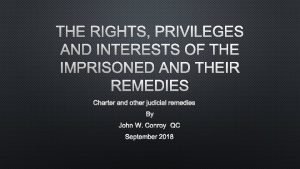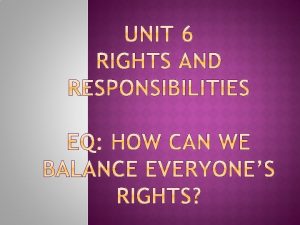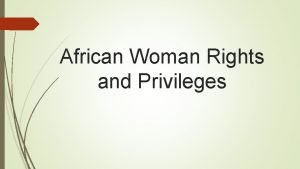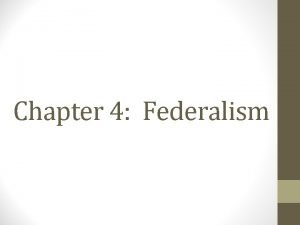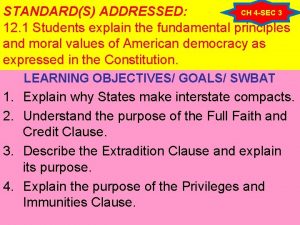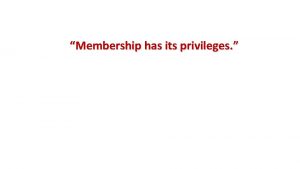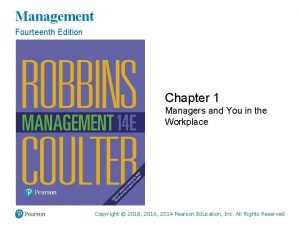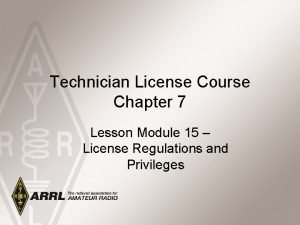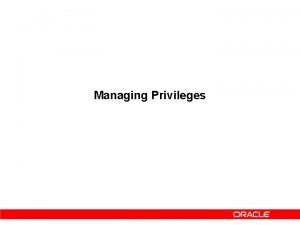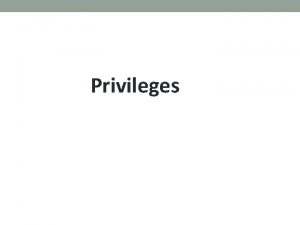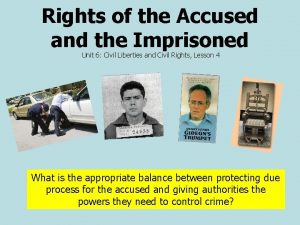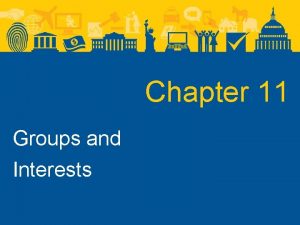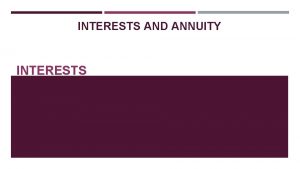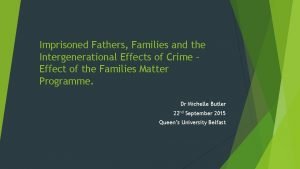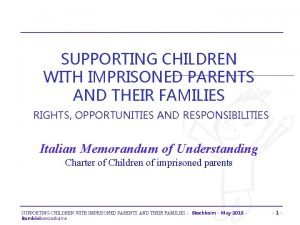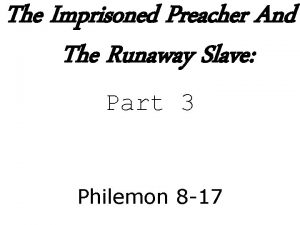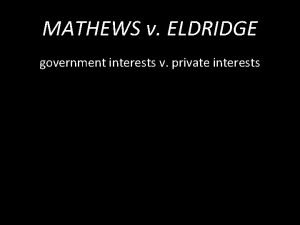THE RIGHTS PRIVILEGES AND INTERESTS OF THE IMPRISONED




























![45] Therefore, the Minister’s decision must meet the above standard to meet the “reasonableness” 45] Therefore, the Minister’s decision must meet the above standard to meet the “reasonableness”](https://slidetodoc.com/presentation_image_h/d487f7078ec66029bdb474ba90b91c5d/image-29.jpg)

![Martineau & Butters v. Matsqui Institution Inmate Disciplinary Board, [1978] 1 S. C. R. Martineau & Butters v. Matsqui Institution Inmate Disciplinary Board, [1978] 1 S. C. R.](https://slidetodoc.com/presentation_image_h/d487f7078ec66029bdb474ba90b91c5d/image-31.jpg)
![Martineau v. Matsqui Institution Inmate Disciplinary Board (No. 2), [1980] 1 S. C. R. Martineau v. Matsqui Institution Inmate Disciplinary Board (No. 2), [1980] 1 S. C. R.](https://slidetodoc.com/presentation_image_h/d487f7078ec66029bdb474ba90b91c5d/image-32.jpg)




- Slides: 36

THE RIGHTS, PRIVILEGES AND INTERESTS OF THE IMPRISONED AND THEIR REMEDIES CHARTER AND OTHER JUDICIAL REMEDIES BY JOHN W. CONROY QC SEPTEMBER 2018

Introduction I was called to the Bar and became a lawyer in 1972 in Vancouver, British Columbia and, after articles and another year practicing civil litigation with a large firm moved back to the Fraser Valley and to a small firm in the spring of 1973 and soon found the civil litigation boring compared to what I was used to (airplane crashes, boat collisions and building collapses to foreclosures and debt collections!) and needed to get on my feet in a courtroom so became a criminal defense lawyer.

After a short period with a local law firm, some involvement other local lawyers and with establishing clinics to assist low income individuals, and regular attendances before the local provincial , then still magistrates court, I got used to watching my clients on their way to prison without giving much thought to what happened to them after they exited the courtroom. I then became exposed to the fact that not only was Abbotsford surrounded by both federal and provincial prisons (the Kingston of the West!), but that the prison population was in significant need of some attention to ensure that the ‘Rule of law’ was being applied behind penitentiary walls

In the legal aid clinics that I participated I learned a little bit about prisons and what was going on in them from students of Professor Michael Jackson at UBC Law school, who where participating in a program that he supervised that took them into the prisons to assist prisoners with legal issues. I remember calling up then Warden of Matsqui institution to advise him that I had been asked to represent prisoner Chico Martineau before the disciplinary court only to be told : "we don't allow lawyers in here!"

Shortly thereafter, I became the lawyer on retainer to the Abbotsford Community Law Office, a new concept in the delivery of legal services to the poor and others, established by then recently elected New Democratic Party government and the demands on my time started coming not only from various groups in the community, but from prisoners, and particularly those in the nearby Matsqui Federal prison. It was also a time when Prof. Jackson enlisted the support and services of lawyers, Bryan Williams and Don Sorochan to challenge the conditions with respect to solitary confinement at the BC Penitentiary (Mc. Cann v the Queen) that ultimately led to a declaration that the conditions and circumstances were cruel and unusual treatment or punishment contrary to then Canadian Bill of Rights, but unfortunately provided no remedy beyond the bare declaration. . .

Before the conclusion of that civil proceeding seeking declaratory relief in the Federal Court trial division in Vancouver, 3 of the Plaintiffs, Andrew Bruce, an aboriginal, Dwight Lucas, a black man and Claire Wilson, a white man, all of whom had been released from solitary, but were being precluded from attending the trial, took 15 people hostages at the BC Pen on June 15, 1975 and sought a plane ride to Cuba and the release of all prisoners in solitary confinement. The event ended tragically with the storming of the vault where the hostages were being held, and the shooting death of Mary Steinhauser, a case worker at the prison thought to be sympathetic to the prisoners circumstances. Some of the prisoners were shot but survived. They were charged with forcible confinement and attempted extortion and tried in January 1977 in New Westminster, BC

I acted as Defense counsel for Dwight Lucas, the black man. After several months of trial before Mr. Justice Toy and a jury, the jury came back after 5 days of deliberations and convicted of the unlawful confinement count but before it was able to render its verdict on the extortion count, the Crown entered a stay of proceedings. Ultimately, they were all sentenced to various sentences concurrent to their already existing life sentences. Because of Prof. Jackson and his classes, students and outreach, I was exposed through these cases, the parties involved, Counsel, the expert and other witnesses to what was going on in our prisons, both in and out of solitary confinement and this had a profound effect upon me in assisting in the creation of a B C Prisoners Legal Services to ensure as then Maguigan Commission said "the Rule of Law must run behind penitentiary walls!“

The current litigation in BC and Ontario to eliminate or at least reduce the use of solitary confinement in our prisons as continuing to be cruel and unusual treatment or punishment but now, contrary to s. 12 of the Canadian Charter of Rights and Freedoms, our entrenched Constitution since 1982, unlike the Canadian Bill of Rights, illustrates that this task is one that is unlikely to ever end and requires constant vigilance by members of the Bar, including the education and development of a younger generation to follow in our footsteps. We are now 2018 and below is what was said in the 18 th and early 19 th century by Dickens and Churchill…

Sir Charles Dickens on solitary confinement in the Eastern State Penitentiary in Philadelphia at the end of the 18 th century. “I believe that very few men are capable of estimating the immense amount of torture and agony which this dreadful punishment, prolonged for years, inflicts upon the sufferers; and in guessing at it myself, and in reasoning from what I have seen written upon their faces, and what to my certain knowledge they feel within, I am only the more convinced that there is a depth of terrible endurance in which none but the sufferers themselves can fathom, and which no man has a right to inflict upon his fellow creature. I hold this slow and daily tampering with the mysteries of the brain to be immeasurably worse than any torture of the body; and because its ghastly signs and tokens are not so palpable to the eye and sense of touch as scars upon the flesh; because its wounds are not upon the surface, and it extorts few cries that human ears can hear; therefore the more I denounce it, as a secret punishment which slumbering humanity is not roused up to stay. ”

Sir Winston Churchill We must not forget that when every material improvement has been effected in prisons, when the temperature has been rightly adjusted, when the proper food to maintain health and strength has been given, when the doctors, chaplains and prison visitors have come and gone, the convict stands deprived of everything that a free man calls life. We must not forget that all these improvements, which are sometimes salves to our consciences, do not change that position. The mood and temper of the public in regard to the treatment of crime and criminals is one of the most unfailing tests of the civilization of any country. A calm and dispassionate recognition of the rights of the accused against the state, and even of convicted criminals against the state, a constant heart-searching by all charged with the duty of punishment, a desire and eagerness to rehabilitate in the world of industry all those who have paid their dues in the hard coinage of punishment, tireless efforts towards the discovery of curative and regenerating processes, and an unfaltering faith that there is a treasure, if you can only find it, in the heart of every man these are the symbols which in the treatment of crime and criminals mark and measure the stored-up strength of a nation, and are the sign and proof of the living virtue in it. House of Commons speech, given as Home Secretary, July 20, 1910

Also during that same time period Professor Ron Price QC, then at Queens University Law School, created the Queens Correctional Law Project, and along with Prof. Alan Manson, involved their students in prison law issues in the Kingston area of Ontario, and developed a vigorous ‘prison law’ Bar in that region. Given the issues arising and the apparent hands-off attitude in existence at the time, it became important to ensure that those running our prisons were accountable to the courts and the law and the focus became how to provide them with effective peaceful remedies instead of allowing things to fester into another riot or hostage taking. .

It used to be that when a person was sentenced to prison he or she was considered to be civilly dead without any remaining rights. Commencing with the work of Prof. Price at Queens and Prof. Jackson at UBC and their students and their efforts with counsel in the courts, followed by our transitioning from a Parliamentary democracy to a Constitutional democracy with a Charter of Rights and Freedoms in 1982, we are now in a position where we have a specific remedy section 24(1) (an ‘appropriate and just remedy’) in the Charter for breaches of one's constitutional rights as well as constitutional guaranteed to Habeas Corpus (s. 10 (c )) and access to the courts for judicial review of administrative decisions.

By virtue of s. 2 (b) of the Canadian Charter of Rights and Freedoms “Everyone” has the fundamental freedom of association” but that freedom, while guaranteed by section 1 is "subject only to such reasonable limits prescribed by law as can be demonstrably justified in a free and Democratic society". A sentence of imprisonment upon conviction for an offense and the administration of that sentence, pursuant to the federal or provincial law in effect is an attempt to provide for such "reasonable limits" and the cases help determine the reasonableness of those laws and the reasonableness of their application in individual and group circumstances and the Charter provides for "an appropriate and just remedy" under section 24(1) in the event of a violation.

The provision for a remedy in the event of the violation of one's constitutional rights, along with the traditional prerogative writs that enable judicial review of administrative actions, namely – Certiorari (moving to quash or set aside a decision), Mandamus (compelling one to do something he or she has a duty to do under the legislation) and prohibition (prohibiting one from doing something they have no jurisdiction to do), continue to apply along with actions for declarations and interim or interlocutory and final injunctions, are the remedies for the peaceful resolution of disputes in the determination of the residual rights of prisoners and the way of ensuring that even the worst person is treated according to law by persons governed by law and complying with the law In addition one must have regard to the Federal Court and Provincial Superior Court Rules as to procedures on ‘applications’ as compared to ‘actions’ and in particular summary or special procedures that enable the expedition to trial of triable issues.

Consequently, leaving aside the very important remedy of Habeas Corpus guaranteed by s. 10(c)the Charter to determine the validity of ones detention , again subject only to “reasonable limits”under s. 1 of the Charter that will be addressed by others, the usual remedy will be for judicial review s. 18 of the Federal Court Act seeking One or more of the traditional prerogative writs and most often to quash or set aside the decision the nature of certiorari. Federal Court Extraordinary remedies, federal tribunals 18 (1) Subject to section 28, the Federal Court has exclusive original jurisdiction (a) to issue an injunction, writ of certiorari, writ of prohibition, writ of mandamus or writ of quo warranto, or grant declaratory relief, against any federal board, commission or other tribunal; and (b) to hear and determine any application or other proceeding for relief in the nature of relief contemplated by paragraph (a), including any proceeding brought against the Attorney General of Canada, to obtain relief against a federal board, commission or other tribunal. Extraordinary remedies, members of Canadian Forces (2) The Federal Court has exclusive original jurisdiction to hear and determine every application for a writ of habeas corpus ad subjiciendum, writ of certiorari, writ of prohibition or writ of mandamus in relation to any member of the Canadian Forces serving outside Canada.

Application for judicial review 18. 1 (1) An application for judicial review may be made by the Attorney General of Canada or by anyone directly affected by the matter in respect of which relief is sought. Time limitation (2) An application for judicial review in respect of a decision or an order of a federal board, commission or other tribunal shall be made within 30 days after the time the decision or order was first communicated by the federal board, commission or other tribunal to the office of the Deputy Attorney General of Canada or to the party directly affected by it, or within any further time that a judge of the Federal Court may fix or allow before or after the end of those 30 days. Remedies to be obtained on application (3) The remedies provided for in subsections (1) and (2) may be obtained only on an application for judicial review made under section 18. 1. R. S. , 1985, c. F-7, s. 18;

Powers of Federal Court (3) On an application for judicial review, the Federal Court may (a) order a federal board, commission or other tribunal to do any act or thing it has unlawfully failed or refused to do or has unreasonably delayed in doing; or (b) declare invalid or unlawful, or quash, set aside or set aside and refer back for determination in accordance with such directions as it considers to be appropriate, prohibit or restrain, a decision, order, act or proceeding of a federal board, commission or other tribunal. Grounds of review (4) The Federal Court may grant relief under subsection (3) if it is satisfied that the federal board, commission or other tribunal (a) acted without jurisdiction, acted beyond its jurisdiction or refused to exercise its jurisdiction; (b) failed to observe a principle of natural justice, procedural fairness or other procedure that it was required by law to observe; (c) erred in law in making a decision or an order, whether or not the error appears on the face of the record; (d) based its decision or order on an erroneous finding of fact that it made in a perverse or capricious manner or without regard for the material before it; (e) acted, or failed to act, by reason of fraud or perjured evidence; or (f) acted in any other way that was contrary to law.

Reference by federal tribunal 18. 3 (1) A federal board, commission or other tribunal may at any stage of its proceedings refer any question or issue of law, of jurisdiction or of practice and procedure to the Federal Court for hearing and determination. Reference by Attorney General of Canada (2) The Attorney General of Canada may, at any stage of the proceedings of a federal board, commission or other tribunal, other than a service tribunal within the meaning of the National Defence Act, refer any question or issue of the constitutional validity, applicability or operability of an Act of Parliament or of regulations made under an Act of Parliament to the Federal Court for hearing and determination. Hearings in summary way 18. 4 (1) Subject to subsection (2), an application or reference to the Federal Court under any of sections 18. 1 to 18. 3 shall be heard and determined without delay and in a summary way. Exception (2) The Federal Court may, if it considers it appropriate, direct that an application for judicial review be treated and proceeded with as an action.

Federal Court Simplified Action Where mandatory 292 Unless the Court orders otherwise, rules 294 to 299 apply to any action in which (a) each claim is exclusively for monetary relief in an amount not exceeding $50, 000, exclusive of interest and costs; (b) in respect of an action in rem claiming monetary relief, no amount claimed, exclusive of interest and costs, exceeds $50, 000; (c) the parties agree that the action is to be conducted as a simplified action; or (d) on motion, the Court orders that the action be conducted as a simplified action.

Cost consequences of improper avoidance of procedure 293 The Court may award costs against any party, including a party who is successful in an action, who it finds has exaggerated a claim, including a counterclaim or third party claim, merely to avoid the operation of rules 292 and 294 to 299. Style of cause 294 Every pleading in a simplified action shall be prefaced by the heading "Simplified Action". List of documents 295 A party to a simplified action may serve, in lieu of an affidavit of documents, a complete list of all the documents in the party's possession, power or control that are relevant to a matter in issue in the action. Limited examination for discovery 296 An examination for discovery in a simplified action shall be in writing only, and shall not exceed 50 questions.

Motion for summary judgment or summary trial 297 No motion for summary judgment or summary trial may be brought in a simplified action. Motions prior to pre-trial conference 298 (1) Subject to subsections (2) and (3), a motion in a simplified action shall be returnable only at a pre-trial conference conducted in accordance with rules 258 to 267. Exception (2) A motion may be brought, within the time set out in rule 204 for the service and filing of a statement of defence, (a) to object to the jurisdiction of the Court; or (b) to strike a statement of claim, on the ground that it discloses no reasonable cause of action. Exception (3) A motion may be brought at any time (a) to remove an action from the operation of rules 294 to 299; (b) for the release of arrested property in an action in rem; or (c) for a default judgment.

Evidence adduced by affidavit 299 (1) In the trial of a simplified action, unless the Court directs otherwise, the evidence of each party shall be adduced by affidavit, which shall, subject to subsections (1. 1) and (1. 2), be served and filed (a) in the case of evidence of a plaintiff, at least 20 days before the trial; and (b) in the case of evidence of a defendant, at least 10 days before the trial Admissibility of expert’s evidence (1. 1) Unless the Court orders otherwise, no evidence in chief of an expert witness is admissible at the trial of an action in respect of any issue unless (a) the issue has been defined by the pleadings or in an order made under rule 265; (b) an affidavit or statement of the expert witness prepared in accordance with rule 52. 2 has been served on all other parties at least 60 days before the commencement of the trial; and (c) the expert witness is available at the trial for cross-examination.

Admissibility of rebuttal evidence (1. 2) Except with leave of the Court, no expert witness’s evidence to rebut evidence in an affidavit or statement served under paragraph (1. 1)(b) is admissible unless an affidavit or statement of the expert witness prepared in accordance with rule 52. 2 has been served on all other parties at least 30 days before the commencement of the trial. Witness to be made available (2) Unless all adverse parties agree otherwise, a witness whose affidavit evidence is tendered at trial shall be made available for cross-examination at trial. Reply evidence (3) Reply evidence, including that of an expert witness, may be provided orally at trial.

www. canadianprisonlaw. ca In my capacity as Counsel to the Abbotsford Community Legal Services Society and then BC Prisoners Legal Services I prepared a 3 volume loose leaf book entitled “Canadian Prison Law” that is essentially an Introduction to prison law together with annotated legislation. I have since managed to put it online with considerable help from my daughter Ginny who is a computer engineer. While the original text and case summaries are still there we have also managed to to link each section to the Canlii database. We are looking for considerable future assistance to keep it up to date and in n that regard I'm hoping that the Canadian Prison Lawyer’s Association that manages the Canadian Prison Lawyer’s listserv will make it available to its members who in turn will contribute cases as they win or lose them with directions to the Editors to summarise them and provide a link in the appropriate spot. Instead of Taking you through number of cases to illustrate the remedies issue over the years I decided to simply indicate that there are now essentially 2 standards review “Correctness” when faced with questions of constitutionality and/or law and “ reasonableness”. A useful summary of the “reasonableness” test provided by Justice Phelan international transfer case called Holmes, below.

Holmes v. Canada (Public Safety and Emergency Preparedness), 2011 FC 112 (Can. LII) http: //canlii. ca/t/2 fk 5 n IV. STANDARD OF REVIEW A. Reasons/Adequacy - Reasonableness [42] Where a ministerial decision has profound impact on an applicant, there is a requirement to inform the person of why a particular result is reached. This is so even where a Minister has a broad discretion. Having said that, the duty to give reasons and the adequacy of reasons do not necessarily require the full analytical force of a Supreme Court of Canada judgment. [43] The Court of Appeal in Vancouver International Airport Authority v. Public Service Alliance of Canada, 2010 FCA 158 (Can. LII), at paragraphs 16 and 17, set forth the purposes of adequate reasons as follows: 16 Where, as here, an administrative decision-maker, acting under a procedural duty to receive and consider full submissions, is adjudicating on a matter of significance, what sort of reasons must it give? From the above authorities, and bearing in mind a number of fundamental principles in the administrative law context, the adequacy of the decision-maker's reasons in situations such as this must be evaluated with four fundamental purposes in mind: (a) The substantive purpose. At least in a minimal way, the substance of the decision must be understood, along with why the administrative decision-maker ruled in the way that it did. (b) The procedural purpose. The parties must be able to decide whether or not to invoke their rights to have the decision reviewed by a supervising court. This is an aspect of procedural fairness in administrative law. If the bases underlying the decision are withheld, a party cannot assess whether the bases give rise to a ground for review.

(c) The accountability purpose. There must be enough information about the decision and its bases so that the supervising court can assess, meaningfully, whether the decision-maker met minimum standards of legality. This role of supervising courts is an important aspect of the rule of law and must be respected: Crevier v. Attorney General of Quebec, 1981 Can. LII 30 (SCC), [1981] 2 S. C. R. 220; Dunsmuir, supra at paragraphs 27 to 31. In cases where the standard of review is reasonableness, the supervising court must assess "whether the decision falls within a range of possible, acceptable outcomes which are defensible in respect of the facts and law": Dunsmuir, supra at paragraph 47. If the supervising court has been prevented from assessing this because too little information has been provided, the reasons are inadequate: see, e. g. , Canadian Association of Broadcasters, supraat paragraph 11. (d) The "justification, transparency and intelligibility" purpose: Dunsmuir, supra at paragraph 47. This purpose overlaps, to some extent, with the substantive purpose. Justification and intelligibility are present when a basis for a decision has been given, and the basis is understandable, with some discernable rationality and logic. Transparency speaks to the ability of observers to scrutinize and understand what an administrative decision-maker has decided and why. In this case, this would include the parties to the proceeding, the employees whose positions were in issue, and employees, employers, unions and businesses that may face similar issues in the future. Transparency, though, is not just limited to observers who have a specific interest in the decision. The broader public also has an interest in transparency: in this case, the Board is a public institution of government and part of our democratic governance structure.

17 The reasons of administrative decision-makers in situations such as this must fulfil these purposes at a minimum. As courts assess whether these purposes have been fulfilled, there a number of important principles, established by the authorities, to be kept firmly in mind: (a) The relevancy of extraneous material. The respondent emphasized that information about why an administrative decision-maker ruled in the way that it did can sometimes be found in the record of the case and the surrounding context. I agree. Reasons form part of a broader context. Information that fulfils the above purposes can come from various sources. For example, there may be oral or written reasons of the decision-maker and those reasons may be amplified or clarified by extraneous material, such as notes in the decision-maker's file and other matters in the record. Even where no reasons have been given, extraneous material may suffice when it can be taken to express the basis for the decision. Baker, supra, provides us with a good example of this, where the Supreme Court found that notes in the administrative file adequately expressed the basis for the decision. See also Hill v. Hamilton-Wentworth Police Services Board, 2007 SCC 41 (Can. LII), [2007] 3 S. C. R. 129 at paragraph 101 for the role of extraneous materials in the assessment of adequacy of reasons

(b) The adequacy of reasons is not measured by the pound. The task is not to count the number of words or weigh the amount of ink spilled on the page. Instead, the task is to ask whether reasons, with an eye to their context and the evidentiary record, satisfy, in a minimal way, the fundamental purposes, above. Often, a handful of well-chosen words can suffice. In this regard, the respondent emphasized that very brief reasons with short-form expressions can be adequate. That is true, as long as the fundamental purposes, above, are met at a minimum. In this regard, the respondent cited the example of the Board sometimes issuing orders without reasons. Whether such orders are adequate depends on the facts of a specific case, but the methodology for assessing adequacy is clear: the preambles, recitals and provisions of the orders, when viewed with an eye to their context and the evidentiary record, must satisfy, in a minimal way, the fundamental purposes, above. (c) The relevance of Parliamentary intention and the administrative context. Judge-made rulings on adequacy of reasons must not be allowed to frustrate Parliament's intention to remit subject-matters to specialized administrative decisionmakers. In many cases, Parliament has set out procedures or has given them the power to develop procedures suitable to their specialization, aimed at achieving cost-effective, timely justice. In assessing the adequacy of reasons, courts should make allowances for the "day to day realities" of administrative tribunals, a number of which are staffed by non-lawyers: Baker, supra at paragraph 44; Clifford v. Ontario Municipal Employees Retirement System (2009), 2009 ONCA 670 (Can. LII), 98 O. R. (3 d) 210 at paragraph 27 (C. A. ). Allowance should also be given for short-form modes of expression that are rooted in the expertise of the administrative decision-maker. However, these allowances must not be allowed to whittle down the standards too far. Reasons must address fundamental purposes - purposes that, as we have seen, are founded on such fundamental principles as accountability, the rule of law, procedural fairness, and transparency. (d) Judicial restraint. The court's assessment of reasons is aimed only at ensuring that legal minimums are met; it is not an exercise in editorial control or literary criticism. See Sheppard, supra at paragraph 26.
![45 Therefore the Ministers decision must meet the above standard to meet the reasonableness 45] Therefore, the Minister’s decision must meet the above standard to meet the “reasonableness”](https://slidetodoc.com/presentation_image_h/d487f7078ec66029bdb474ba90b91c5d/image-29.jpg)
45] Therefore, the Minister’s decision must meet the above standard to meet the “reasonableness” standard of review required by Dunsmuir v. New Brunswick, 2008 SCC 9 (Can. LII) Conclusion it is now clear that in Canada while a prisoner loses many general rights and freedoms upon imprisonment he or she continues to have certain residual liberties as reflected in the Corrections and Conditional Release Act and its regulations and other related statues, and the Canadian Charter of Rights and Freedoms. Federal and Provincial Ministers and Correctional Administrators are accountable to the courts in relation to purely administrative decisions affecting the rights, interests, and privileges of prisoners both federal and provincial by way of the Constitutional remedy of habeas corpus under s. 10 of the Charter and traditional applications and actions both in the Federal court and Provincial Superior Courts to ensure that Constitution and “The Rule of Law” runs behind prison walls.

Below are some of the cases involving various remedies that I explored and became involved with over the years and , time permitting, I will explain some of the stories behind them: Regina v. Bruce, Wilson and Lucas (1977), 36 C. C. C. (2 d) 158 (B. C. S. C. ) (The B. C. Penitentiary Steinhauser Hostage Taking. ) This is the case referred to above involving the hostage taking at the BC penitentiary in 1975. The defense admitted 95% of the Crown's case and submitted that the evil they committed by taking hostages was a lesser evil than the continued imposition of cruel and unusual treatment or punishment contrary, the Canadian Bill of Rights and that they had tried to exhaust their peaceful legal remedies to no avail. In other words the ‘defense of necessity’ that the evil they committed was a lesser evil than the violation of their rights under the Bill of Rights and they had exhausted their legal remedies. The subsequent Farris Commission of Inquiry into the death of Mary Steinhauser pointed the finger at one of the guards for mixing up the guns subsequently so it could not be determined who had the gun with the lanyard ring that had fired the fatal shot. This incident was the subject of much Media comment and ultimately was made into a play and later a movie called "Walls" by Christian Bruyere.
![Martineau Butters v Matsqui Institution Inmate Disciplinary Board 1978 1 S C R Martineau & Butters v. Matsqui Institution Inmate Disciplinary Board, [1978] 1 S. C. R.](https://slidetodoc.com/presentation_image_h/d487f7078ec66029bdb474ba90b91c5d/image-31.jpg)
Martineau & Butters v. Matsqui Institution Inmate Disciplinary Board, [1978] 1 S. C. R. 118, 14 N. R. 285, 33 C. C. C. (2 d) 366, 74 D. L. R. (3 d) 1 (S. C. C. ) (The meaning and scope of s. 28 of the Federal Court Act and its relationship to s. 18 of that Act in the context of Federal Prison Disciplinary proceedings. ) In those early days to establish judicial review we were faced with old law that said that only decisions made on a "judicial or quasi-judicial basis" were subject to judicial review. The disciplinary courts determining guilt or innocence of penitentiary offenses and imposing sanctions, including periods in solitary confinement, certainly appeared to fit within that categorization and section 28 of the Federal Court Act then provided a remedy for review of such tribunals directly in the Court of Appeal. Because the rules surrounding the disciplinary courts were not in the Penitentiary Act or regulations, but in Commissioner's directives it was held that the proceedings were "not required by law" to be conducted on a judicial or quasi-judicial basis so the Court of Appeal lacked jurisdiction over "purely administrative decisions.
![Martineau v Matsqui Institution Inmate Disciplinary Board No 2 1980 1 S C R Martineau v. Matsqui Institution Inmate Disciplinary Board (No. 2), [1980] 1 S. C. R.](https://slidetodoc.com/presentation_image_h/d487f7078ec66029bdb474ba90b91c5d/image-32.jpg)
Martineau v. Matsqui Institution Inmate Disciplinary Board (No. 2), [1980] 1 S. C. R. 602, 30 N. R. 119, 106 D. L. R. (3 d) 385, 50 C. C. C. (2 d) 353 (S. C. C. ) (The meaning of s. 18 of the Federal Court Act, the ambit and scope of certiorari, the duty to act fairly, and judicial review of prison disciplinary matters in Canada. ) When the Court of Appeal ruled that it did not have jurisdiction under section 28 of the Federal Court Act we then proceeded with an application under s. 18 for certiorari or judicial review which then traditionally also required the decision below to be characterized as "judicial or quasi-judicial". We had filed this application at the same time as the section 28 application and then left it in abeyance pending that proceeding. Consequently, this proceeding would determine the ambit and scope of 'certiorari' and the meaning of section 18. We established that it applied to purely ‘administrative decisions’ and that the "duty to act fairly" applied and was required to be followed in the exercise of the disciplinary court's jurisdiction. Judicial review and accountability to the courts and the rule of law was established in relation to purely administrative decisions within the prisons affecting the rights, privileges, or interests of prisoners. If the matter involved an emergency, the duty to act fairly ( "the right to know the case against you and the right to have a fair opportunity to respond to it ") was required to be complied with as soon as possible thereafter. A failure to comply with the duty to act fairly results in a loss of jurisdiction and a setting aside or quashing of the decision

Re Bruce et al & Reynett et al (1980), 48 C. C. C. 313, (1979), 4 W. W. R. 408, (F. C. T. D. ) (The ambit and scope of quo warranto, the jurisdiction of prison wardens to deny prisoners applications to get married, the applicability of the duty to act fairly in relation to transfers of prisoners. ) Re Bruce et al. & Yeomans et al (1980), 49 C. C. C. (2 d) 346, (1979), 10 C. R. (3 d) 166, (F. C. T. D. ) (The transfer of prisoners and the duty to act fairly. ) Truscott v. Director of Mountain Institution et al (1983), 4 C. C. C (3 d) 199 3 C. R. (3 d) 121 (B. C. C. A. ) (National Parole Board "gating" practice declared unlawful. ) A Practice developed called “gating” if the cfc was of the view that a prisoner posed to great a risk to reoffend at the time of reaching ‘statutory release’ at 2/3 of their centre and would normally be entitled to their release subject to continued supervision until Warrant expiry they would take them out of the prison and then immediately suspended them and return them to custody without any post release misconduct. This practice was declared unlawful and that suspension required some post release misconduct. Subsequently the government amended the Penitentiary and Parole Acts to specifically provide the power to the Parole Board of Canada to so detain at statutory release until warrant expiry subject to reviews.

Regina v. Mingo et al (1983), 2 C. C. C. (3 d) 23 (B. C. S. C. ) (The Kent Prison Riot, Res Judicata issues between Criminal Code proceedings and Prison disciplinary proceedings, Abuse of process, Double Jeopardy s. 11(h) of the Charter. ) In Re Cardinal & Oswald (1986), 23 C. C. C. (3 d) 118, 1 W. W. R. 577, (S. C. C. ) The ambit of habeas corpus with or without certiorari in aid in relation to solitary confinement in Canada. Counsel in B. C. S. C. and B. C. C. A. only. Regina v. Taylor, Hansen, Stewart, Hannah & Belmas (B. C. S. C. ) (The Squamish Five). Counsel to Julie Belmas at Trial and in subsequent B. C. Board of Parole and National Parole Board matters. See also sentence appeal (1986), 27 C. C. C. (3 d) 142 (B. C. C. A. ) Landry v. Legal Services Society (1987), 28 C. C. C. (3 d) 138 (B. C. C. A) (The unavailability of Legal Aid for prison disciplinary matters in B. C. ) Winters v. Legal Services Society (1999) 3 S. C. R. 160 (SCC). The Legal Services Society of British Columbia is required to provide legal aid to federal prisoners facing serious disciplinary charges for which, upon conviction, they could be sent to solitary confinement. Mooring v. National Parole Board [1996] 1 S. C. R. 75; (1996), 104 C. C. C. (3 d) 97. On February 8 th, 1996, the Supreme Court of Canada reversed the decision of the British Columbia Court of Appeal which had held that the National Parole Board was a "court of competent jurisdiction" pursuant to s. 24(1) and (2) of the Canadian Charter of Rights and Freedoms so that it had the jurisdiction to determine the admissibility and exclusion of evidence before it.

Horii v. Correctional Service of Canada et al, (5 September 1991), No. A-841 -91 (F. C. A. ). It used to be that women sentenced to federal time in prison would be required to choose either to do their time at the federal Prison for Women at Kingston Ontario or in their province of origin under the provincial corrections regime. A Declaration was sought that this violated section 15 of Charter and an interlocutory injunction obtained pending trial restraining the transfer of the only female prisoner at a male institution. This was a Court Challenges Program funded test case in relation to equality rights for women prisoners under s. 15 of the Charter. This case was ultimately settled out of court. A Prison for Women now exists in B. C. and federal women are no longer shipped out of province or forced to do their federal time in a provincial facility. Cruikshanks v. David Stephen, Parole Officer, Correctional Service of Canada, National Parole Board and Arthur Trono, Warden, William Head Institution (17 July 1992), No. VI 01627, Victoria Registry, (B. C. C. A. ). (Conditions of mandatory supervision to furnish urinalysis samples constitutes a breach of s. 8 of the Charter. ) Regina v. Cochrane, (10 February 1994), No. CA 015972, Vancouver Registry, (B. C. C. A. ). A sentence for a fixed term of years cannot be imposed consecutively to a life sentence and any provision in the Criminal Code (such as s. 85(2) requiring a consecutive sentence for the use of a firearm in the commission of an offence) which requires a consecutive sentence must be read so that it does not apply to produce a consecutive sentence to a life sentence. Parliament must be taken to have known the law and not to have required a logical impossibility

Sauve v. Canada (Chief Electoral Officer) (2002) S. C. C. 68 (SCC). Counsel for the BC Civil Liberties Association Intervener – S. 51(e) of the Canada Elections Act which purported to deny the right to vote to “every person who is imprisoned in a correctional institution serving a sentence of two years or more” is unconstitutional as contravening s. 3 of the Canadian Charter of Rights and Freedoms – the right of every citizen to vote in Federal elections and is not a reasonable limit that is demonstrably justified under s. 1 of the Charter. The Court rejected the government’s argument that to deny the right to vote to penitentiary inmates required deference because it is a matter of social and political philosophy. The Court held that it was not appropriate on a decision to limit fundamental rights to defer to competing social and political policies and that limits on the right to vote did not require deference, but careful examination because the framers of the Charter had signalled the special importance of this right not only due to its broad language, but also because it was exempted from the legislative override under s. 33 of the Charter (the notwithstanding clause). Parliament cannot use lofty objectives to shield legislation from Charter scrutiny and failed to identify particular problems to support that a denial of the right to vote was directed at oppressing its substantial purpose. The government’s vague and symbolic objectives were not supported by the record. Further, s. 51(e) did not meet the proportionality test as it failed to establish a rational connection between it and the stated objectives. Further denial of the vote to right on the basis of attributed moral unworthiness was inconsistent with the respect for the dignity of every person that lies at the heart of Canadian democracy and the Charter. Denying the right to vote as part of the punishment served no valid criminal purpose nor the record nor common sense supported a claim that disenfranchisement deterred crime or rehabilitated criminals. The denial of the right to vote was not rationally connected to the government’s goal and did not minimally impair the right to vote. The negative effects of denying citizens the right to vote greatly outweighed the tenuous benefits that might ensue, imposes negative costs on prisoners and the penal system and removes a route to social development and undermines correctional law and policy directed towards to rehabilitation and reintegration. It would also have a disproportionate impact on Canada’s disproportionately incarcerated aboriginal population.
 Rights and privileges
Rights and privileges Rights vs privileges
Rights vs privileges Rights vs privileges
Rights vs privileges Rights vs privileges
Rights vs privileges Imprisoned sight
Imprisoned sight Privileges and immunities clause examples
Privileges and immunities clause examples No state can make unreasonable distinctions
No state can make unreasonable distinctions What exception if any permits a private pilot
What exception if any permits a private pilot Positive rights vs negative rights
Positive rights vs negative rights Duty towards self
Duty towards self Legal rights and moral rights
Legal rights and moral rights Negative right
Negative right Membership has its privileges
Membership has its privileges Management involves coordinating and overseeing
Management involves coordinating and overseeing Weakness in isolation, privileges
Weakness in isolation, privileges Weakness in isolation privileges
Weakness in isolation privileges Full faith & credit vs. privileges & immunities
Full faith & credit vs. privileges & immunities Technician class privileges
Technician class privileges Sql authorization mechanism grants privileges on
Sql authorization mechanism grants privileges on Sql authorization mechanism grants privileges on
Sql authorization mechanism grants privileges on My hobbies images
My hobbies images Riparian or littoral rights
Riparian or littoral rights Positive and negative rights
Positive and negative rights Positive vs negative rights
Positive vs negative rights Rosalind hursthouse
Rosalind hursthouse Hobbies and interests difference
Hobbies and interests difference Difference of interest and hobbies
Difference of interest and hobbies Stakeholders and their interests
Stakeholders and their interests Tiny rascal gang
Tiny rascal gang Difference between interests and hobbies
Difference between interests and hobbies Describing hobby
Describing hobby Hobbies of a teacher
Hobbies of a teacher 5 hobbies you need
5 hobbies you need Personality test unifrog
Personality test unifrog Questions free time activities
Questions free time activities What do you like to do in your free time
What do you like to do in your free time What is an executory interest
What is an executory interest
